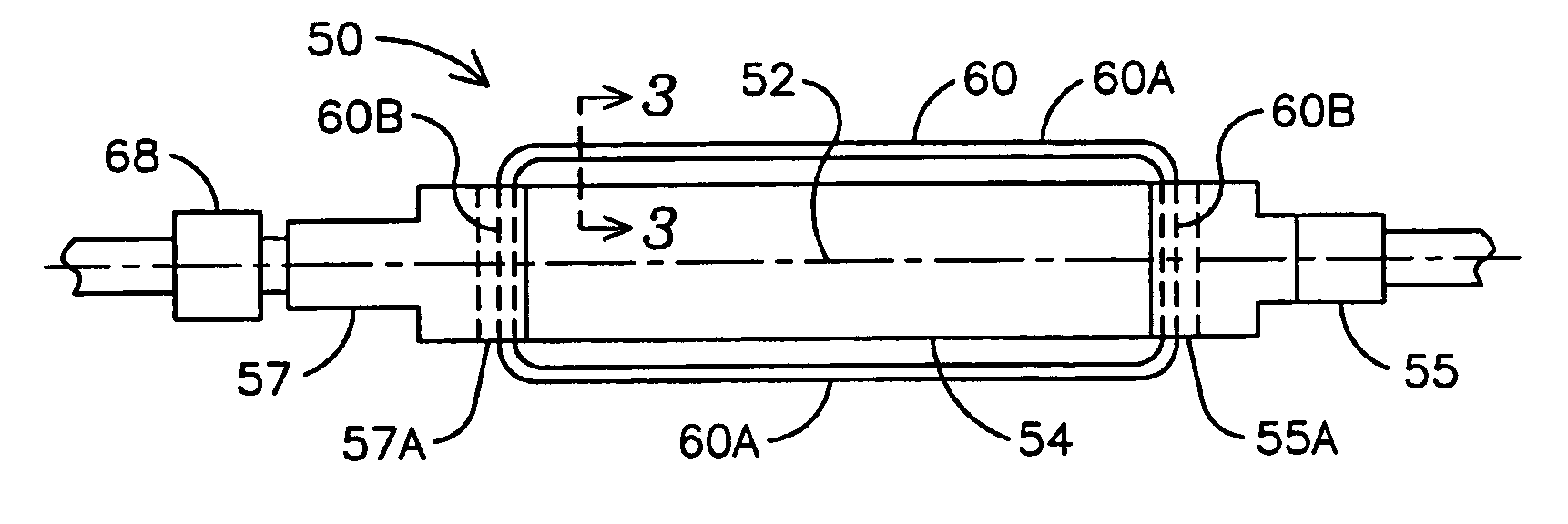Superconducting coil support structures
a superconducting coil and support structure technology, applied in the direction of windings, magnetic circuit rotating parts, magnetic circuit shapes/forms/constructions, etc., can solve the problems of reducing the power efficiency of the generator, carrying a substantial electric current, and mechanically massive and electrically complex structures
- Summary
- Abstract
- Description
- Claims
- Application Information
AI Technical Summary
Problems solved by technology
Method used
Image
Examples
first embodiment
[0030]Existing non-superconducting dynamoelectric machines, such as the electric generator 10 of FIG. 1, may be retrofitted by replacing the non-superconducting rotor 12 with a superconducting rotor 50 illustrated in FIG. 2. The superconducting rotor 50 defines a longitudinally-extending axis 52 and comprises a generally cylindrically-shaped core 54 and coaxially aligned rotor end segments 55 and 57 each attached to an end surface of the core 54. A material of the core 54 exhibits a high magnetic permeability, e.g. a ferromagnetic material such as iron.
[0031]The superconducting rotor 50 further comprises a generally longitudinally-extending, racetrack-shaped superconducting coil or winding 60 comprising generally linear axial segments 60A connected by radial segments 60B, the latter extending through openings 55A and 57A between end surfaces of the core 54 and the respective end segments 55 and 57. In certain embodiments a vacuum shield, not shown in FIG. 2, surrounds the supercondu...
second embodiment
[0059]Another embodiment of a coil support structure of the present invention (illustrated in FIGS. 5A, 5B, 5C and 6) comprises a compression support structure 200 (see FIG. 5A) for supporting the three exemplary parallel superconducting blocks 106A, 106B and 106C against lateral loads (tangential loads with respect to the rotor core). The compression support structure 200 comprises overhang frames 202 (constructed from a material having a high thermal resistance such as fiber reinforced plastic). Base regions 202A of the overhang frames 202 extending beyond side surfaces of a conductor enclosure 212 are attached to the rotor core 54 by any suitable fastening technique. In another embodiment the base regions 202A are attached to a casing structure (not shown) surrounding the compression support structure 200 and attached to the core 54. The shape of the illustrated overhang frame 202 is merely exemplary as the shape can be optimized in response to expected normal and fault condition...
third embodiment
[0071]Another embodiment of a compression-type coil support 300 is illustrated in a perspective view of FIG. 7 and a sectional view of FIG. 8. Posts 308 are fixedly attached to the core 54 (not shown) (for example, threads formed in a lower region of the posts 308 threadably engage a mating threaded opening in the core 54). In conjunction with a plate 312 and a nut 314 (or another fastener as known by those skilled in the art) configured as illustrated, each post 308 exerts a compressive (radially inwardly directed) force on the superconducting block 106 and fiberglass reinforced plastic elements 315 disposed within wells 316 in sidewall surfaces of a conductor enclosure 318 to transfer the compressive force exerted by the plates 312 to the conductor enclosure 316, thereby compressively biasing the conductor block 106.
PUM
 Login to View More
Login to View More Abstract
Description
Claims
Application Information
 Login to View More
Login to View More - R&D
- Intellectual Property
- Life Sciences
- Materials
- Tech Scout
- Unparalleled Data Quality
- Higher Quality Content
- 60% Fewer Hallucinations
Browse by: Latest US Patents, China's latest patents, Technical Efficacy Thesaurus, Application Domain, Technology Topic, Popular Technical Reports.
© 2025 PatSnap. All rights reserved.Legal|Privacy policy|Modern Slavery Act Transparency Statement|Sitemap|About US| Contact US: help@patsnap.com



